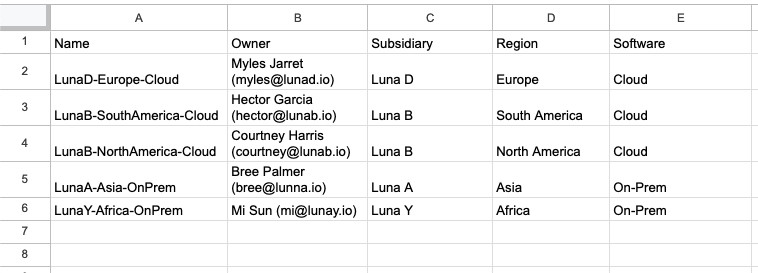Importing scopes
Roles and permissions
Only administrators can import scopes
If your organization has a large number of scopes, you can import them into Hyperproof via CSV.
Importing hierarchical scopes (child scopes) is not supported at this time.
Note
The steps on this page walk you through importing scopes into Hyperproof via Settings > Scopes. If you want to import scope assignments that are linked to controls, refer to Importing scope assignments.
Tip
Adding additional information does not overwrite existing data. During the import, Hyperproof searches for any exact data identifiers. If it doesn’t find any, it treats the data as new. If it finds a match, it updates the existing data.
Step One: Downloading the example CSV
The easiest way to start importing scopes is by downloading Hyperproof’s example CSV. The example CSV file provides the exact template for successfully importing scopes into Hyperproof.
From the left menu, select Settings.
Select Scopes.
Click Import.
The Import scopes window opens.
Click Download the example CSV.
Step Two: Editing the CSV
Replace the contents of the example CSV file with your own scopes. Be sure to follow the format of the example file, as well as the instructions on the page, to ensure that your scopes can be successfully imported.
Note
The CSV must contain ALL headings listed below, even if they are optional. Keep in mind that headings are case-sensitive!
Heading | |
|---|---|
Name | This is the name of the scope. This field is required. TipAs a best practice, scope names should be searchable by their dimension value(s), e.g. LunaB-NorthAmerica-Cloud, where 'Luna B' is the subsidiary, 'North America' is the region, and 'Cloud' is the software. This allows scopes to act as another layer of data management for your organization. This also applies to scopes without custom fields, e.g. 'HR' for human resources. Additionally, commas are not supported in scope names. |
Owner | Must be formatted as FirstName LastName (email address), i.e. Jennifer Cook (jcook@lunabtechnologies.org). This is an optional field. Tip: If no scope owner is provided, the scope is assigned to the individual who imports the CSV. Additional tip: The owner's email address must match the email address they use to sign in to Hyperproof. |
Custom fields |
Below is a snippet of a sample import file.

Step Three: Importing the CSV
After you’ve made the necessary changes to the CSV, it can be imported into Hyperproof.
Drag and drop the CSV file into the Upload CSV File field, or click Select file to upload to upload it manually.
Click Import.
Hyperproof checks the CSV to ensure that there are no errors. You’ll be alerted if Hyperproof encounters any errors.
If Hyperproof didn’t detect any errors, click Next. If Hyperproof detected errors, do one or both of the following:
First, use the Error viewer to identify the errors. Second, correct the errors directly in the CSV. This ensures that the CSV is up-to-date should you need to re-import in the future.
Tip
Use the forward and backward arrows to cycle through the errors. The Error viewer gives specific information on what needs to be corrected.
Remove rows that contain errors by clicking Remove all rows with errors. Note that this doesn't remove any data in the actual CSV.
Click Next.
The CSV is imported.